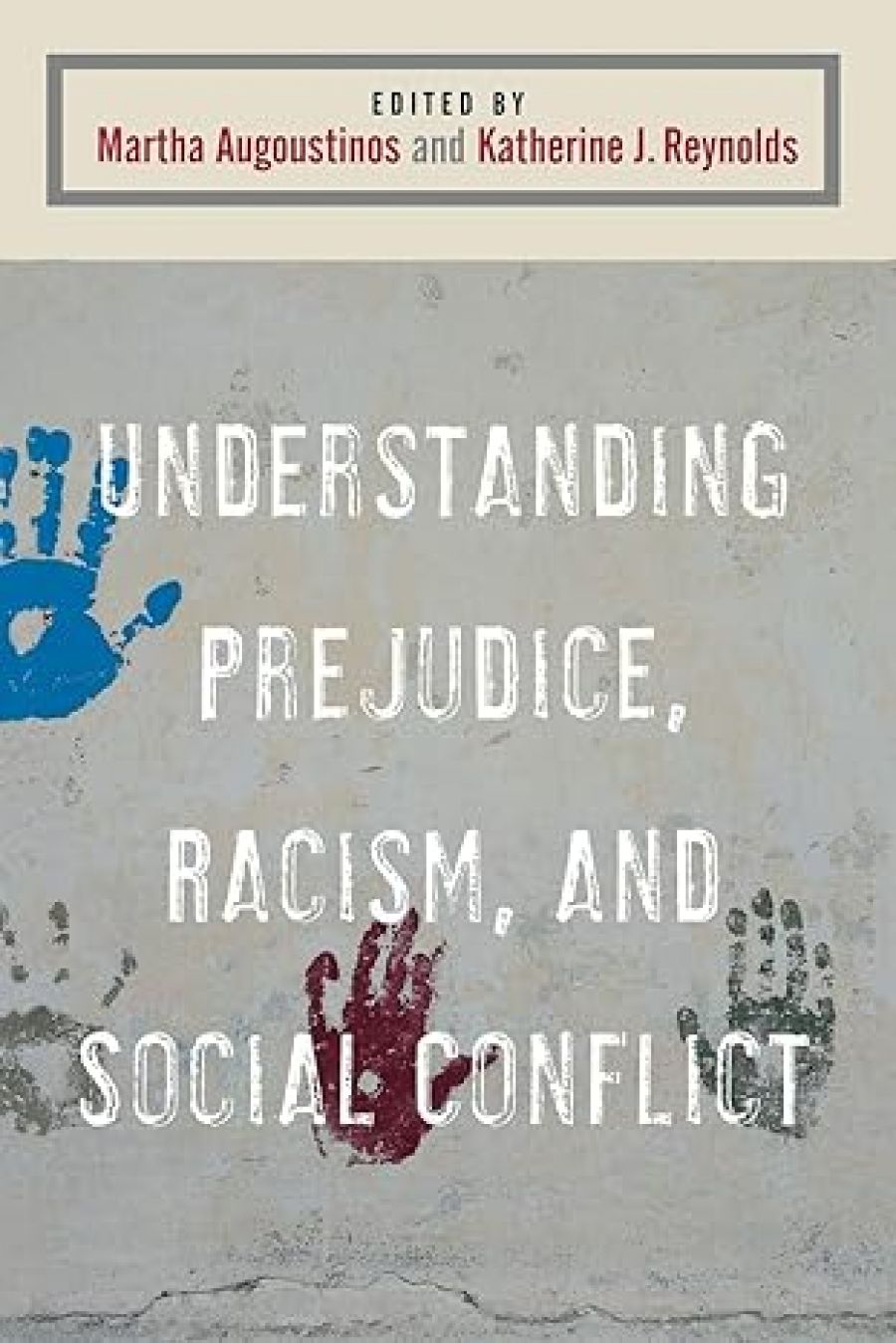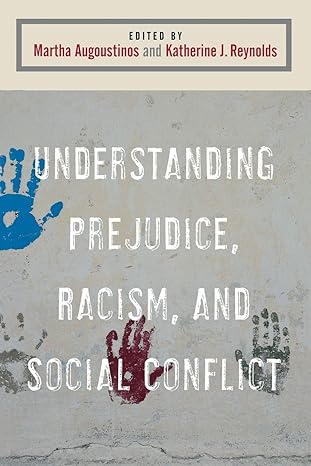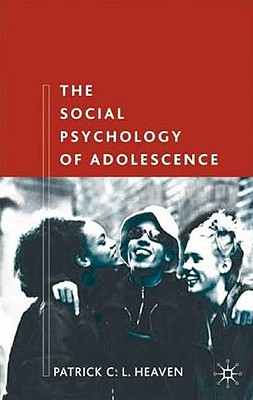
- Free Article: No
- Contents Category: Politics
- Review Article: Yes
- Article Title: Oiling the Mechanics of Racism
- Online Only: No
- Custom Highlight Text:
Martha Augoustinos and Katherine J. Reynolds have edited an intellectually substantial collection of essays on a timely topic. The ease with which the perception of group difference can be cultivated and transformed into the perception of a threat, as seen in the rise of One Nation and, more recently, in the Australian community’s response to asylum seekers, sharpens the need for such a collection. It is not enough for those of us concerned by the inherent racism of the government’s policies, and the public approval of them, to point out either its irrational character or its inhumanity. If our opposition is to be effective, we need to understand the mechanics of racism. This book so thoroughly explores and elucidates those mechanisms, from the level of individual personality to politics, that I began to suspect the government front bench of using it as a guidebook. More seriously, I marvelled at its effective use of the interplay between social and political structures, policies and individual psychology in order to secure political advantage. John Duckitt’s ‘Reducing Prejudice: An Historical and Multi-Level Approach’ presents an overview of strategies and policies found to be effective in countering racism so precisely opposed to the policies and practices now in place in Australia that those policies and practices take on the appearance of a photographic negative.
- Book 1 Title: Understanding Prejudice, Racism, and Social Conflict
- Book 1 Biblio: Sage Publications, $65 pb, 378 pp
- Book 1 Cover Small (400 x 600):

- Book 1 Cover (800 x 1200):

- Book 2 Title: The Social Psychology of Adolescence
- Book 2 Biblio: Palgrave, $53.90 pb, 313 pp
- Book 2 Cover Small (400 x 600):

- Book 2 Cover (800 x 1200):

Prejudice in individuals is argued to be strongly associated with right-wing authoritarianism and social dominance orientation: ‘a generalized belief in social inequality and the right of powerful groups to dominate weaker ones.’ Duckitt points out that these ideological and social attitudes are influenced by a belief that the world is either a dangerous place or a ‘competitive, inegalitarian jungle, in which the strong succeed and dominate and the weak fail’. Conversely, Duckitt claims that ‘the perception of the social world as egalitarian, fair, cooperative, and altruistic is strongly associated with tolerance and non-prejudice’. Directives from legitimate authority figures to adopt more tolerant attitudes can be effective in reducing prejudiced behaviour in individuals with authoritarian tendencies. A liberal education that increases cognitive sophistication through exposing individuals to ‘a diversity of ideas and perspectives’ is also an effective counter to both prejudice and authoritarianism. It seems clear that there is much that a government genuinely concerned about racism and prejudice could do. So what does it do?
In its rhetoric on asylum seekers, border security and the ‘war on terror’, our government presents the outside world as a dangerous and threatening place (and thus makes it more so). In its competition, workplace and social security policies, it views the world as a competitive jungle in which the strong justifiably take the spoils, and places rigorous strictures on aid to the weak. Federal education policies have encouraged the proliferation of small sectarian schools, many of which actively discourage critical thinking or exposure to a diversity of views. Education that is narrowly focused on inculcation of traditional norms or ‘conservative-achievement’ does not reduce prejudice. Moreover, those learning in such controlled settings will be more susceptible to group stereotyping and less likely to have the kinds of experiences that challenge it.
Governments do not need to address or explicitly endorse racist attitudes at an individual level to produce them. They can create an environment in which prejudice flourishes in pursuit of quite other ideological goals. But their success in denying this effect of their policies requires explanation. Modern racism eschews many of the crudities of the past. As argued in Amanda Le Couteur and Martha Augoustinos’s joint essay – a discussion about race – members of majority groups commonly appropriate egalitarian and supposedly neutral and objective language. As an example, they quote ‘A’:
whenever something doesn’t go the group’s way they cry discrimination … with the Aborigines if they don’t get something it’s discrimination for females it’s the same, with other minority groups it’s all the same … And I think that discrimination is now an excuse people are using or a crutch that if something doesn’t go their way it’s sort of like a child throwing a tantrum … I know it does exist and it shouldn’t but it’s been taken vast advantage of.
Here, minority group members are seen as using their minority status to try to gain an unfair advantage. The speaker represents himself as attached to the value of fairness, surely the antithesis of the irrational discrimination of the past. We see a similar rhetorical move in the asylum-seeker debate, where asylum seekers are represented as queue jumpers, as trying to take unfair advantage of Australian generosity, and our response to them as an utterly reasonable attempt to restore equity and order to immigration. Race, allegedly, is irrelevant. Mark Rapley’s contribution ‘How To Do X without Doing Y: Accomplishing Discrimination without Being Racist’ elaborates on the use of this technique in public life with his analysis of John Howard’s address to the nation on native title.
While the editors have consciously tried to remedy what they see as the dominance of socio-cognitive theories of prejudice and stereotyping that focus on the individual and present prejudice and racism as multi-level phenomena, questions of group and individual identity loom large in this collection and also in Patrick Heaven’s The Social Psychology of Adolescence, where the central adolescent task of constructing one’s own identity is examined. How are the individual, group and national identity shaped? What are the roles played by individual personality traits, parental styles, social groups, and social and political structures in constructing identity? How fixed, how malleable, are these identities?
The self is a work in progress, and one that adolescents are deeply engaged in. It is not, as Heaven points out, and parents will readily affirm, a stress-free exercise. ‘It is fraught with challenges to one’s attitudes, values and behaviours.’ Adolescents construct their identities along a variety of dimensions, trying on different roles and modes of behaviour as they go. Important here are friendships, gaining a vocational identity that signals new-found independence from family, and arriving at a personal philosophy or guiding set of values. While some adolescents foreclose on this task by adopting the beliefs and wishes of their parents, this does not seem, in the light of the research on prejudice and racism examined above, altogether desirable. Such teenagers, who generally endorse ‘authoritarian values, obedience, strong leadership and respect for authority’, may give their parents and teachers an easy ride, but they may also lack the capacity for critical reflection and decision-making at both a personal and political level that provides a bulwark against manipulation by authority figures. Their inflexibility, reflected in their unrealistic responses to failure, also places them at a disadvantage in times of radical change. So what should parents do to support healthy identity formation without taking over the process? The book’s survey of parenting styles and outcomes is probably insufficiently rich and explanatory to satisfy such parental curiosity, but it provides a starting point.
These books can be profitably read by those outside the discipline, but they do require some commitment. Heaven’s book is pitched at students rather than the educated general audience that Augoustinos and Reynolds also hope to attract. It is likely that they will reach only the converted, but the virtue of their collection is that it will also thoroughly educate them in the best sense of the word.


Comments powered by CComment